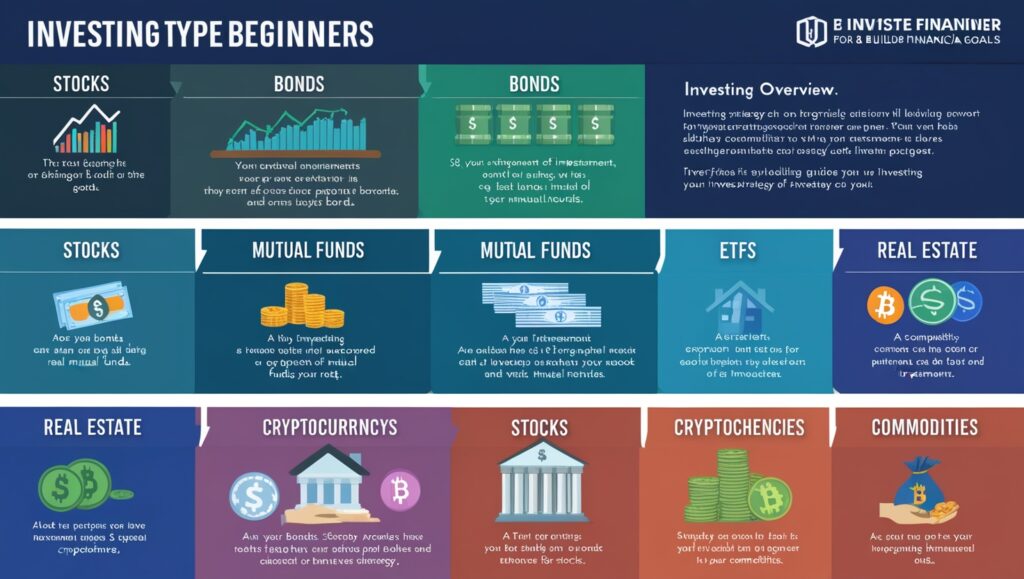Understanding Different Types of Investments A Beginners Guide
Investing can seem daunting, especially for beginners. With various options available, understanding the different types of investments is crucial for making informed decisions that align with your financial goals. This guide will provide an overview of the primary investment types, their characteristics, potential returns, and associated risks.
1. Stocks
What Are Stocks?
Stocks represent ownership in a company. When you purchase a stock, you buy a small piece of that company, making you a shareholder.
Potential Returns
Investing in stocks can offer high potential returns through capital appreciation (the increase in the stock’s price) and dividends (a portion of the company’s profits paid to shareholders).
Risks
Stocks can be volatile, with prices fluctuating significantly based on market conditions, company performance, and economic factors. It’s possible to lose money if a company underperforms or if the overall market declines
2. Bonds
What Are Bonds?
Bonds are debt securities issued by governments, municipalities, or corporations to raise capital. When you buy a bond, you are lending money to the issuer in exchange for periodic interest payments and the return of the bond’s face value at maturity.
Potential Returns
Bonds typically offer lower returns than stocks but are considered safer. They provide regular income through interest payments, making them suitable for conservative investors.
Risks
The primary risk associated with bonds is interest rate risk; when interest rates rise, existing bonds may decrease in value. There’s also credit risk if the issuer fails to make interest or principal payments.
3. Mutual Funds
What Are Mutual Funds?
Mutual funds pool money from multiple investors to purchase a diversified portfolio of stocks, bonds, or other securities, managed by a professional fund manager.
Potential Returns
Mutual funds can provide diversification, reducing risk while offering the potential for decent returns based on the fund’s performance. They are suitable for investors seeking a hands-off approach.
Risks
While diversification can mitigate risks, mutual funds are still subject to market risk. Additionally, management fees can affect overall returns.
4. Exchange-traded funds (ETFs)
What Are ETFs?
ETFs are similar to mutual funds but trade on stock exchanges like individual stocks. They track an index, commodity, or basket of assets.
Potential Returns
ETFs often have lower expense ratios than mutual funds and provide diversification. They offer the potential for capital appreciation and are suitable for both long-term and short-term investors.
Risks
ETFs are subject to market risks similar to stocks. The value can fluctuate based on the performance of the underlying assets.
5. Real Estate
What Is Real Estate Investing?
Real estate investing involves purchasing properties for rental income or resale. It can include residential, commercial, or industrial properties.
Potential Returns
Real estate can generate regular rental income and appreciate in value over time. Additionally, it offers tax advantages and a hedge against inflation.
Risks
Real estate investments require substantial capital, and property values can fluctuate due to market conditions. Additionally, managing properties can be time-consuming and require ongoing expenses.
6. Cryptocurrency
What Is Cryptocurrency?
Cryptocurrency is a digital or virtual currency that uses cryptography for security. Bitcoin and Ethereum are two of the most well-known cryptocurrencies.
Potential Returns
Cryptocurrencies can offer high returns due to their volatility and growing acceptance. Some investors see them as a hedge against inflation.
Risks
Cryptocurrencies are highly speculative and can be extremely volatile. Regulatory changes, security breaches, and market sentiment can significantly impact prices.
7. Commodities
What Are Commodities?
Commodities are physical goods such as gold, oil, agricultural products, and natural gas. Investors can purchase commodities directly or through futures contracts.
Potential Returns
Investing in commodities can provide diversification and a hedge against inflation. Prices often move independently of stock and bond markets.
Risks
Commodities can be volatile and are influenced by supply and demand dynamics, geopolitical factors, and economic conditions.
Final Thoughts
Understanding different types of investments is essential for beginners looking to build wealth and achieve financial goals. Each investment type has its unique characteristics, potential returns, and risks. It’s important to assess your risk tolerance, investment horizon, and financial objectives before diving into the world of investing.
As you begin your investment journey, consider diversifying your portfolio to spread risk and enhance potential returns. Whether you choose stocks, bonds, real estate, or other options, starting early and staying informed will help you navigate the investment landscape successfully. Always consider seeking advice from a financial advisor to tailor an investment strategy that meets your specific needs and goals.

